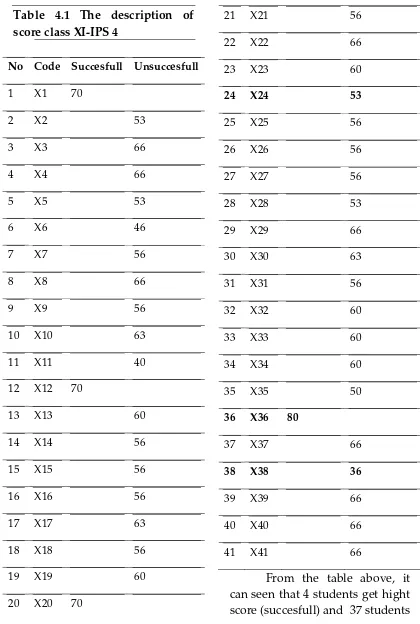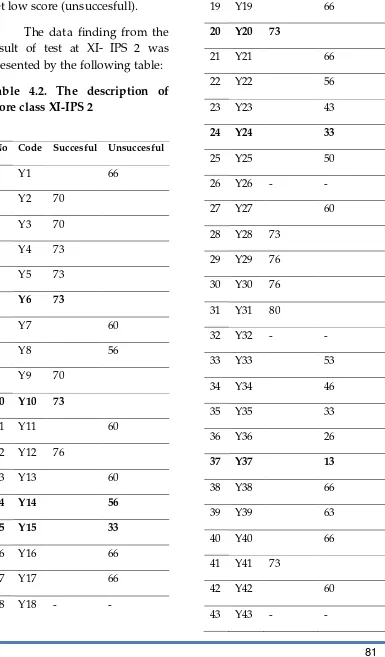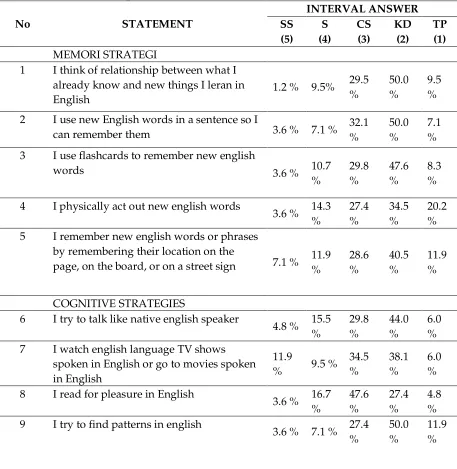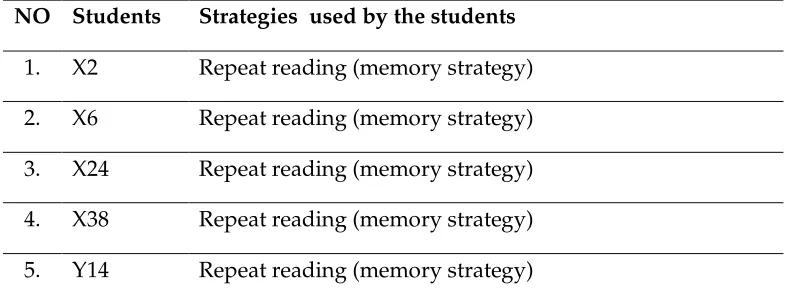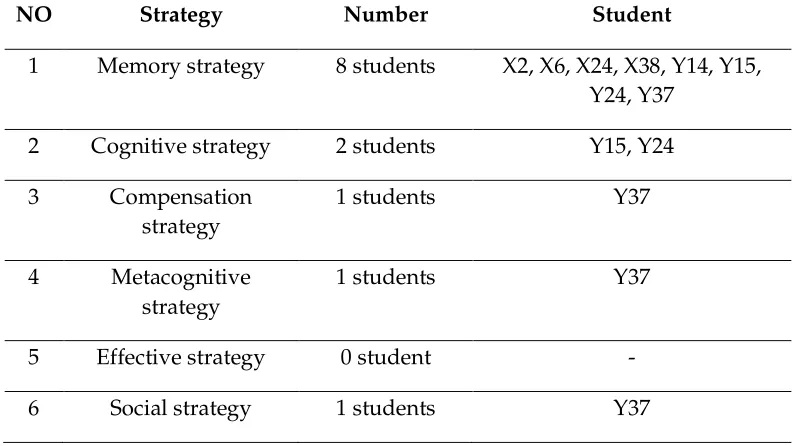IAIN Palangka Raya, Cent r al Kalimant an, Indonesia, 25 June 2016
73
LANGUAGE LEARNING STRATEGIES APPLIED BY SENIOR HIGH SCHOOL STUDENTS
Dewi Kurniawati & Santi Erliana [email protected]
IAIN Palangka Raya
Abstract
This study was at investiagated the language learning strategies applied by successful and unsuccessful students at SMAN 4 Palangka Raya. This study is mixed research. Mixed method research design is a procedure for collecting, analyzing, and “mixing” both quantitative and qualitative research and methods in a single study to understand a research problem. The findings show that the successful students could get the highest score they applied some language learning strategies for reading such as; memory strategy, cognitive strategy, compensation strategy, metacognitive strategy, affective strategy, and social strategy. Meanwhile, the unsuccessful students got the lowest score in comprehending report text because they could not apply their learning strategies accurately.
Keywords: language learning strategy, successful student, unsuccessful students
INTRODUCTION
In this chapter the writer explains about background of the study, problems of the study, the objectives of the study, significant of the study, limitation of study, definition of key terms, framework of discussion, and frame of thinking.
As one of the language skills, reading is important aspect in reading English. In reading the student should be able to read, detect, and select the right cues from concepts or meaning. Besides that the purpose of reading is to recognize word meaning, phrases sentence structure, and discourse analysis.1 It could be taken conclusion that the purpose of reading is the
1
IAIN Palangka Raya, Cent r al Kalimant an, Indonesia, 25 June 2016
74 students should understand about the meaning of the text that was read by them.
In senior high school such as SMAN 4 Palangka Raya, English lesson is taught and one of material that given by the teacher to the students the eleventh grade. The teacher often gives material by using reading or writing.
Oxford defines learning strategies are steps taken by students to enhance their own learning. Strategies are especially important for language learning because they are tools for active competence. Appropriate language learning strategies result in improved proficiency and greater self-confidence.2
Based on the background of the study above, the problems of the study are formulated as follows:
1. What are the language learning strategies applied by the successful students at SMAN 4 Palangka Raya?
2. What are the language learning strategies applied by the unsuccessful students at SMAN 4 Palangka Raya?
3.
The writer hopes that this research has significance in the language learning strategies, especially in comprehending report text for the eleventh grade students. There are two kinds of significance. Theoretically, this study gives information about the language learning strategies by the eleventh grade students at SMAN 4 Palangka Raya. This study also to give contribution as the material for the other researchers and as the library references. Practically, this study has two significances: first, this study gives for the teacher information about the students’ ability in reading English text so that they can improve their teaching strategy in helping their students.
REVIEW OF RELATED LITERATURE
In this chapter the writer explains about the nature of reading, the level of reading, problems in reading comprehension, the teaching English at SMAN 4 Palangka Raya, Language learning strategies, and the previous related of study.
The Nature of Reading
1. Reading
2
IAIN Palangka Raya, Cent r al Kalimant an, Indonesia, 25 June 2016
75 According to Fauziati reading is a process of decoding written symbols, working from smaller units (individual letters) to large ones.3 Meanwhile in oxford dictionary explained that reading is the action of person who reads, another opinion is stated by Nurhadi and Roekhan, and they stated that reading is process done to achieve the message, information, or case in the text.4
2. Reading Comprehension
Carrel in Brown defines that reading comprehension is seen as an interactive process between the text and the reader’s prior knowledge, is shown trough practical classroom application.5
3. Type of reading comprehension
According to Burns, type of reading comprehension divided into two classes, literal comprehension and order comprehension. Higher-order comprehension includes interpretive, critical, and creative comprehension
a. Literal comprehension
The basic of literal comprehension is state information. The specific, explicitly stated parts of a paragraph or passage that contain the basic information are the details on which main ideas, cause and effect relationships, inference, and so on that built.
b. Interpretive reading
Interpretive reading is reading between the lines of making inferences. It is the process of deriving ideas that are implied rather than directly state.
c. Critical reading
Critical reading is evaluating written material-comparing the idea discovered in the materials with known standards and drawing conclusions about their accuracy, appropriateness, and timeliness.
d. Creative reading
Creative reading involves going beyond the material presented by author. To go beyond the material in the text, readers must make use of their background schemata, combining this prior knowledge with ideas
3
Ibid, p.136
4
Nurhadi and Roekhan, Dimensi-dimensi pengajaran dalam bahasa kedua, Bandung: Sinar Baru, 1990, p.191.
5
IAIN Palangka Raya, Cent r al Kalimant an, Indonesia, 25 June 2016
76 from the text to produce a new response based on, but not completely dictated by the text. Creative readers must be skilled in the following areas. 6
4. Problems in reading comprehension
According to Gebhard there are some problems in reading, they are: a. The “ I want reading faster” problem
Some students want to read faster but they do not know increase their reading speed. Some of them complain that they read too slowly, one reason is because the material is too difficult
b.The “vocabulary building” problems
It is not just beginner who needs to work constantly on building vocabulary. Some students have problems in comprehending the content of reading material because they limited vocabulary.
c. The “background knowledge” problem
Students’ ability to comprehend the content of reading material depends on their knowledge about the topic of the reading selection d.The “getting students to read” problem
It is sometimes difficult to get students to read in and out of class. Students, young and old are not always motivated to read.7
5. Reading Test
Here the writer chooses multiple choices as her examination for the students at SMAN 4 Palangka Raya. According to Richard R. day and Jeong Suk Park, multiple choice formats give the students some possible answers. Students might be able to check the text to see if any of the choices are specifically discussed, and then make a choice.8
Language Learning Strategies
1. The Nature of Language learning strategies
Language learning strategies are specific actions, behaviors, steps, or techniques that students (often intentionally) use to improve their progress in developing L2 skills.
6
Paul C, Burns and Friends, Teaching Reading Today’s Elementary Schools, Boston: Houghton Mifflin Company. P.207.
7
Jerry G. Gebhard, Teaching English as a Foreign Language, America: The University of Michigan Press, 1996, p.209.
8
IAIN Palangka Raya, Cent r al Kalimant an, Indonesia, 25 June 2016
77
2. Kinds of Language Learning strategies in Reading
Oxford divides language learning strategies into two main classes, direct and indirect, which are further subdivided into 6 groups.
Learning Strategies
Previous Studies
In order to provide strong foundation, some related studies are listed as follows: The first researcher was Niah Handayani (The Islamic State Istitute Of Palangka Raya, 2010), who conducted an action research entitled “language learning strategy applied by successful students in English of second year at MAN Model of Palangka Raya” as the previous of the study. The result of her study discussed that were had different in playing their strategies in English
The fourth Researcher was Rahmadi Nirwanto is entitled “The language Leraning Strategies as Employed by the successful students of the English education study program of IAIN Palangka Raya in writing Course”. This research showed that, the successful students of the English education study program of IAIN Palangka Raya in writing courses used the strategies: memory, cognitive, metacognitive, compensation, affective and social strategies.
RESEARCH METHOD
In this chapter the writer explains about the time and place of the study, approach and type of the study, subject and object of the study, data collecting procedures, Endorsement of data, and data analysis procedure. The study was conducted for two months at SMAN 4 Palangka Raya. It is on Jln.Sisingamangaraja III, Palangka Raya, Central Kalimantan on April to Mei 2016.
In this study is mixed research. Mixed method research design is a
Direct Strategies
Indirect strategies
M em ory st rat egies
Cognitive strategies
Compensation strategies
Metacognitive Strategies
Affective strategies
IAIN Palangka Raya, Cent r al Kalimant an, Indonesia, 25 June 2016
78 procedure for collecting, analyzing, and “mixing” both quantitative and qualitative research and methods in a single study to understand a research problem.9 To find out the students’ score in comprehending report text, the writer used quantitative approach. The writer divided the student’s score into two categories, low score (successful students) and high score (unsuccessful students) after giving the test. While, to know and describe the strategies used by the successful and unsuccessful students, the writer used qualitative approach.
The subject of this study was the eleventh grade students of SMAN 4 of Palangka Raya. The numbers of the subject were 391 students.
1. Sample : XI-IPS 4 and XI-IPS 2 were selected used purposive sampling.
Data Collecting Techniques
To collect the data, the writer used some techniques, such as; test administration, questionnare distribution, interview, and documentation. 1. Test
The first instrument is test, it is used to obtain the students’ reading skill and to catagorize the students score into successful and unsuccessful students.
2. Questionnaire
This technique applied to accomplish the data about the language learning strategies in comprehending report text applied by the second year students at SMAN 4 of Palangkaraya. The questionnaire consist of 30 items. They got five answers’ option: always(SS), often (S), usually (CS), seldom (KD), never (TP).
3. Interview
The interview was conducted to get data about the students’ language learning strategies in comprehending report text. Interview was used to get information of the main study. The writer asked their language learning strategies and knows their reason why they use that strategy.
4. Documentation
9
Creswell, J. (2012).Educational research: Planning, conducting, and evaluating quantitative and qualitative research
IAIN Palangka Raya, Cent r al Kalimant an, Indonesia, 25 June 2016
79 Documentation is every written material or film.10 This technique is used to collect the data, which is related to the research. It was used to support the data through documents or writings that relation with this study. The data taken from some cases as follows:
a. The amount, the name, and the students’ registration number of the second year students at SMAN 4 of Palangka Raya.
b. The syllabus of English subject and Score of the Student.
FINDINGS AND DISCUSSION
Result of the study
In collecting data, test, questionnaire, interview, and documentation were used. In this research was used a questioning test in order to know the students’ ability and to classify the students into successful or unsuccessful students. After knowing the students ability and classifying the students into the successful and unsuccessful students, the writer gave the students language learning’s’ interviewed the successful and unsuccessful students to know their learning strategies.
1. Test
Based on the test, the writer would expose data finding from the result of test was presented by the following table.
10
IAIN Palangka Raya, Cent r al Kalimant an, Indonesia, 25 June 2016
80
Table 4.1 The description of score class XI-IPS 4
No Code Succesfull Unsuccesfull
1 X1 70
2 X2 53
3 X3 66
4 X4 66
5 X5 53
6 X6 46
7 X7 56
8 X8 66
9 X9 56
10 X10 63
11 X11 40
12 X12 70
13 X13 60
14 X14 56
15 X15 56
16 X16 56
17 X17 63
18 X18 56
19 X19 60
20 X20 70
21 X21 56
22 X22 66
23 X23 60
24 X24 53
25 X25 56
26 X26 56
27 X27 56
28 X28 53
29 X29 66
30 X30 63
31 X31 56
32 X32 60
33 X33 60
34 X34 60
35 X35 50
36 X36 80
37 X37 66
38 X38 36
39 X39 66
40 X40 66
41 X41 66
IAIN Palangka Raya, Cent r al Kalimant an, Indonesia, 25 June 2016
81 get low score (unsuccesfull).
The data finding from the result of test at XI- IPS 2 was presented by the following table:
Table 4.2. The description of score class XI-IPS 2
No Code Succesful Unsuccesful
1 Y1 66
2 Y2 70
3 Y3 70
4 Y4 73
5 Y5 73
6 Y6 73
7 Y7 60
8 Y8 56
9 Y9 70
10 Y10 73
11 Y11 60
12 Y12 76
13 Y13 60
14 Y14 56
15 Y15 33
16 Y16 66
17 Y17 66
18 Y18 - -
19 Y19 66
20 Y20 73
21 Y21 66
22 Y22 56
23 Y23 43
24 Y24 33
25 Y25 50
26 Y26 - -
27 Y27 60
28 Y28 73
29 Y29 76
30 Y30 76
31 Y31 80
32 Y32 - -
33 Y33 53
34 Y34 46
35 Y35 33
36 Y36 26
37 Y37 13
38 Y38 66
39 Y39 63
40 Y40 66
41 Y41 73
42 Y42 60
IAIN Palangka Raya, Cent r al Kalimant an, Indonesia, 25 June 2016 82 From the table above, it can seen that 14 students get hight score (succesfull) and 29 students get low score (unsuccesfull).
In this study, the writer only took the successful and the unsuccessful students to answer the interview to know their strategies in reading. From every class the writer has chosen four students who got hight score and four students who got low score.
2. Result of the Questionnaire
Based on the questionare, the writer would expose data finding from the result of questionare was presented by the following table:
Table 4.3. The result of prosentase Questionnaire
No STATEMENT
INTERVAL ANSWER SS (5) S (4) CS (3) KD (2) TP (1) MEMORI STRATEGI
1 I think of relationship between what I
already know and new things I leran in English
1.2 % 9.5% 29.5
%
50.0 %
9.5 %
2 I use new English words in a sentence so I
can remember them 3.6 % 7.1 %
32.1 % 50.0 % 7.1 %
3 I use flashcards to remember new english
words 3.6 % 10.7
% 29.8 % 47.6 % 8.3 %
4 I physically act out new english words
3.6 % 14.3
% 27.4 % 34.5 % 20.2 %
5 I remember new english words or phrases
by remembering their location on the
page, on the board, or on a street sign 7.1 % 11.9 % 28.6 % 40.5 % 11.9 %
COGNITIVE STRATEGIES
6 I try to talk like native english speaker
4.8 % 15.5
% 29.8 % 44.0 % 6.0 %
7 I watch english language TV shows
spoken in English or go to movies spoken in English
11.9
% 9.5 %
34.5 % 38.1 % 6.0 %
8 I read for pleasure in English
3.6 % 16.7
% 47.6 % 27.4 % 4.8 %
9 I try to find patterns in english
3.6 % 7.1 % 27.4
%
50.0 %
IAIN Palangka Raya, Cent r al Kalimant an, Indonesia, 25 June 2016 83
10 I find the meaning of an English word by
dividing it into parts that I understand 6.0 % 7.1 % 34.5
% 36.9 % 15.5 % COMPENTATION STRATEGIES
11 To undesrtand unfamiliar English words, I
make guesses 6.0 %
14.3 % 26.2 % 41.7 % 11.9 %
12 When I can’t think of a word during a
conversation in English, I use gestures 2.4 % 11.9 % 29.8 % 36.9 % 19.0 %
13 I make up new words if I do not know the
right ones in English 4.8 % 8.3 %
32.1 % 33.3 % 21.4 %
14 I try to guess what the other person will
say next in English 2.4 %
15.5 % 27.4 % 32.1 % 22.6 %
15 If I can’t think of an english word, I use a
word or phrase that means the same thing 7.1 % 14.3
% 20.2 % 32.1 % 26.2 % METACOGNITIVE STRATEGIES
16 I notice my english mistakes and use that
information to help me do better. 6.0 %
11.9 % 31.0 % 33.3 % 17.9 %
17 I pay attention when someone is speaking
English -
11.9 % 23.8 % 46.4 % 17.9 %
18 I try to find out how to be a better learner
of English 3.6 % 13.1 % 23.8 % 44.8 % 15.5 %
19 I look for people I can talk to in English
4.8 % 14.3
% 20.2 % 41.7 % 19.0 %
20 I have clear goals for improving my
english skills 6.0 % 10.7
% 29.8 % 41.7 % 11.9 % AFFECTIVE STRATEGIES
21 I think about my progress in learning
English 8.3 % 14.3
% 29.8 % 38.1 % 9.5 %
22 I try to relax whenever I feel afraid of
using English 4.8 %
13.1 % 33.3 % 39.3 % 9.5 %
23 I encourage myself to speak english even
when I am afraid of making a mistake 1.2 % 7.1 % 36.9
%
45.2 %
9.5 %
24 I give myself a reward or treat when I do
IAIN Palangka Raya, Cent r al Kalimant an, Indonesia, 25 June 2016 84
25 I talk to someone else about how I feel
when I am learning Englis 8.3 % 7.1 %
29.8 % 36.9 % 17.9 % SOCIAL STRATEGIES
26 If I do not understand something in
english, I ask the other person to slow
down or say it again 7.1 %
11.9 % 22.6 % 47.6 % 10.7 %
27 I ask english speakers to correct me when I
talk -
11.9 % 29.8 % 47.6 % 10.7 %
28 I practice english with other students
3.6 % 7.1 % 27.4
%
48.8 %
13.1 %
29 I ask for help from english speakers
2.4 % 13.1
% 23.8 % 42.9 % 17.9 %
30 I try to learn about the culture of english
speakers. 2.4 %
11.9 % 10.7 % 35.7 % 39.3 %
3. The result of interview
The Successful Students by their Language Learning Strategies
NO Students Strategies used by the students
1. X1 Repeat reading (memory strategy), made a summary (Cognitive
strategy), asked using English (Compensation strategy), comparing the ability with others (affective strategy), ask friends to correct the English comprehension (Social strategy)
2. X12 Repeat reading (memory strategy), made a summary (cognitive strategy)
3. X20 Repeat reading (memory strategy), asked using English language
(metacognitive strategy)
4. X36 Repear reading (memory strategy), for remembering new words in the
English language, he made it in the form of sentences (cognitive strategy), compare the understanding of the English language with others (affective strategy)
5. Y6 Repear reading (memory strategy), made a summary (cognitive strategy)
6. Y10 Reading newspaper or magazine in English (memory strategy), repeat
IAIN Palangka Raya, Cent r al Kalimant an, Indonesia, 25 June 2016 85
7. Y20 Repeat reading (memory strategy), asking using English language
(compensation strategy), using English language in dialogue with friends (metacognitive strategy), compare the ability in English with other (affective strategy)
8. Y31 Repeat reading (memory strategy)
Based on the table above, it could be seen there were some strategies used by the successful students in comprehending report text. The table below shown the strategies used and the number of students used its:
Table 4.5. The Language Learning Strategies applied by successful students and the number of students applied its
NO Strategy Number Student
1 Memory strategy 8 students All of
2 Cognitive strategy 4 students X1, X12, X36, Y6
3 Compensation strategy 2 students X1, Y20
4 Metacognitive strategy 3 students X1, X20, Y20
5 Effective strategy 2 students X1, X36
6 Social strategy 1 student X1
Finally, the successful students could get the highest score because they can regocnize and apply their strategies correctly and carefully.
Table 4.6. The Unsuccessful Students by their Language Leraning Strategies
NO Students Strategies used by the students
1. X2 Repeat reading (memory strategy)
2. X6 Repeat reading (memory strategy)
3. X24 Repeat reading (memory strategy)
4. X38 Repeat reading (memory strategy)
IAIN Palangka Raya, Cent r al Kalimant an, Indonesia, 25 June 2016 86
6. Y15 Repeat reading (memory strategy), could understand the
reading quickly if there is an image (memory strategy), made a summary (cognitive strategy)
7. Y24 Reading english newspaper or magazine (memory
strategy), repeat reading (memory strategy), for remembering new words tried to made it in a sentence (cognitive strategy)
8. Y37 Repeat reading (memory strategy), asked using English
(Compensation strategy), dialogue with friends using English (metacognitive strategy), express the English language in written form (Social strategy)
Based on the table above, it could be seen the strategies used by the unsuccessful students in comprehending report text. The table shown the strategies used and the number of students used its.
Table 4.7. The Language Learning Strategies applied by unsuccessful students and the number of students applied its
NO Strategy Number Student
1 Memory strategy 8 students X2, X6, X24, X38, Y14, Y15,
Y24, Y37
2 Cognitive strategy 2 students Y15, Y24
3 Compensation
strategy
1 students Y37
4 Metacognitive
strategy
1 students Y37
5 Effective strategy 0 student -
6 Social strategy 1 students Y37
IAIN Palangka Raya, Cent r al Kalimant an, Indonesia, 25 June 2016 87 DISCUSSION
Based on the result findings above, the successful students could get the highest score by applying their learning strategies. They had kinds of language learning strategies, such as: memory strategy 100 % of the usage (reading English newspaper and English magazine, repeat reading). Cognitive strategy 50 % of the usage (made a summary, made word in the form of sentence). Compensation strategy 25 % of the usage (asked using English). Metacognitive strategy 37,5 % of the usage (tried using English in dialogue with friends). Affective strategy 25% of the usage (compare the ability in English with others). Social strategy 12,5 % of the usage (aks friends to correct the English comprehension).
In other hand, the unsuccessful students also had learning strategies, but they could not apply it. The unsuccessful students got the lowest score because they could not apply their learning strategies accurately. Although, they got the lowest score, but they also had the language learning strategy, such as using memory strategy 100 % of the usage (reading English magazine and English newspaper, repeat readings if he did not understand the contents of the text and could understand the reading quickly if there is an image). Cognitive strategy 25 % of the usage (for remembering new words, tried to made it in a sentence, made a summary for easy reading in understanding the content of the English language). Compensation strategy 12,5% of the usage (asked using English). Metacognitive strategy 12,5 % of the usage (dialogue with friends using the English language, making its own schedule for studying English). Affective strategy 0 % of the usage (compare the ability with others). Social strategy 12,5 % of the usage (ask a friend or someone else to proofread the English language comprehension).
CONCLUSION
1. The successful students could get the highest score they applied some language learning strategies for reading such as; memory strategy (reading English newspaper and English magazine, repeat reading). Cognitive strategy (made a summary, made words in the form of sentence). Compensation strategy (asked using English). Metacognitive strategy (tried using English in dialogue with friends). Affective strategy (compare the ability in English with others). Social strategy (aks friends to correct the English comprehension).
IAIN Palangka Raya, Cent r al Kalimant an, Indonesia, 25 June 2016 88 new words, tried to made it in a sentence, made a summary for easy reading in understanding the content of the English language). Compensation strategy (asked using English). Metacognitive strategy (dialogue with friends using the English language, making its own schedule for studying English). Affective strategy (compare the ability with others). Social strategy (ask a friend or someone else to proofread the English language comprehension).
SUGGESTION
1. For the English teacher
The teacher is suggested to increase their knowledge about it and motivate them to learn spritely. The teacher also should increase the techniques of teaching that can motivate the students to give more attention to the teacher explanations.
2. For the students
They should apply the suitable, variety and correct strategies. Then, they should always try to increase their skill by practicing in every day. So, it is expected that the students are able to explore their skills maximally and really know about some language learning strategies especially the application in usage it.
3. For the future researcher
Finally, the writer suggests for other researchers who were interested in researching about language learning strategy to make the similar researches in other language skills, such as learning for writing, listening, and speaking.
References
Anderson, Jonathan. 1965. Efficcient Reading A Practical Guide. Sydney: Hill book company.
Arikunto, Suharsimi. 2003. Prosedur Penelitian suatu Pendekatan Praktek,.Jakarta: PT. Rineka Cipta.
Brown. H Dougles. 2001. Teaching By Principles an Interactive Approcah to Language Pedagogy.San fransisco State univ.
Cooper, David J. 1986. Improving Reading Comprehension. Boston. Houghton Miffin Company
Creswell, J. (2012).Educational research: Planning, conducting, and evaluating quantitative and qualitative research (4thed.).Upper Saddle River, NJ: Pearson Education. Fathoni, Abdrurrahman, 2006. Methodology Penelitian Dan Teknik Penyusunan Skripsi,
Jakarta, Rineka Cipta.
IAIN Palangka Raya, Cent r al Kalimant an, Indonesia, 25 June 2016 89 H Johnston, Peter . 1983.reading Comprehension Assessment Cognitive Basis. Delaware:
Internasional Reading Association.
Hilda karli and Oditha R, Hutabarat. 2009. Implementasi KTSP. Jakarta: General info Media.
Interview with Mr.I on January15th,2016 at 10.00a.m in SMAN 4 Palangka Raya Jerry G. Gebhard. Teaching and Learning in the secondary school. New fetter lane: the
open university London
Moleong, Lexy J. 2001. Metodologi Penelitian Kualitatif. Bandung: Remaja Rosdakarya. Nasution, 2004. Metode Research, Jakarta: Bumi Aksara.
Nirwanto, Rahmadi. 2009. The Language learning strategies as Employed by the Successful Students of the English Education Study Program of IAIN Palangka Raya in writing Course.
Nurhadi and Roekhan, 1990. Dimensi-dimensi Pengajaran dalam Bahasa Kedua, Bandung: Sinar Baru.
Paul C, Burns and Friends, Teaching Reading Today’s Elementary schools. Boston: Houghton Mifflin Company.
Pumfrey, 1976. Peter D. Reading Test and assessment Techniques, London: Hodder and Stoughton.
Rahardjo,Mudjia.2002.Pengantar penelitian Bahasa,Malang:cendika Para Mulya. Rebecca L. Oxford. 1990. language Learning Strategies, New York: Newbury House
Publisher.
Richard R, Day, and friend, 2005, Developing Reading Comprehension questions’ Reading in a Foreign Language, volume.
Rochiati Wiriaatmadja. 2006. Metode Penelitian Tindakan Kelas. Bandung: Remaja Rosdakarya.
Schwartz,Steven. 1984. Measuring Reading competence.New York:Plenum Press. Siahan, Sanggam. 1995. Issues in Linguistics. Yogyakarta: graham Ilmu.
Silvia, Arnis. 2010.The Analysis of Language Learning Strategies (LLSs) Applied by the Learners of the First Grade Acceleration and Regular Class at SMAN 1 Jember in Academic Year 2009/2010.
Snow, Catherine E, and friend. 2003. Rethinking Reading Comprehension, New York: The Guildford Press
Sudarwati, M. 2006. Look ahead an English course for Senior high school students year XI, Jakarta: Erlangga.
Sugiyono, 2006. Metode Penelitian Pendidikan: Pendekatan Kuantitatif, Kualitatif dan R&D, Bandung: Alfabeta.
Sutrisno Hadi. 2004. Metodologi Research Jilid 2, Yogyakarta: Andi
